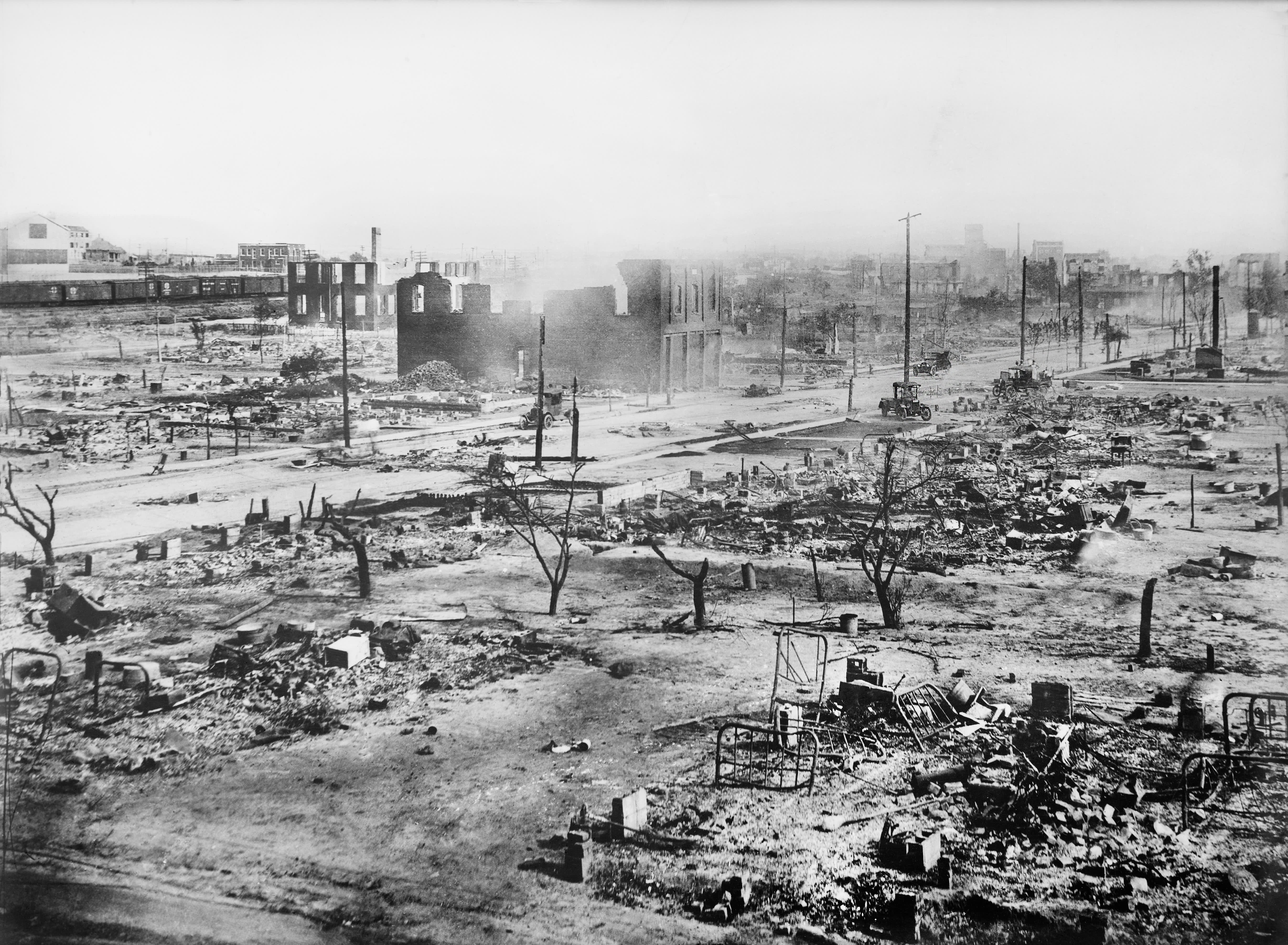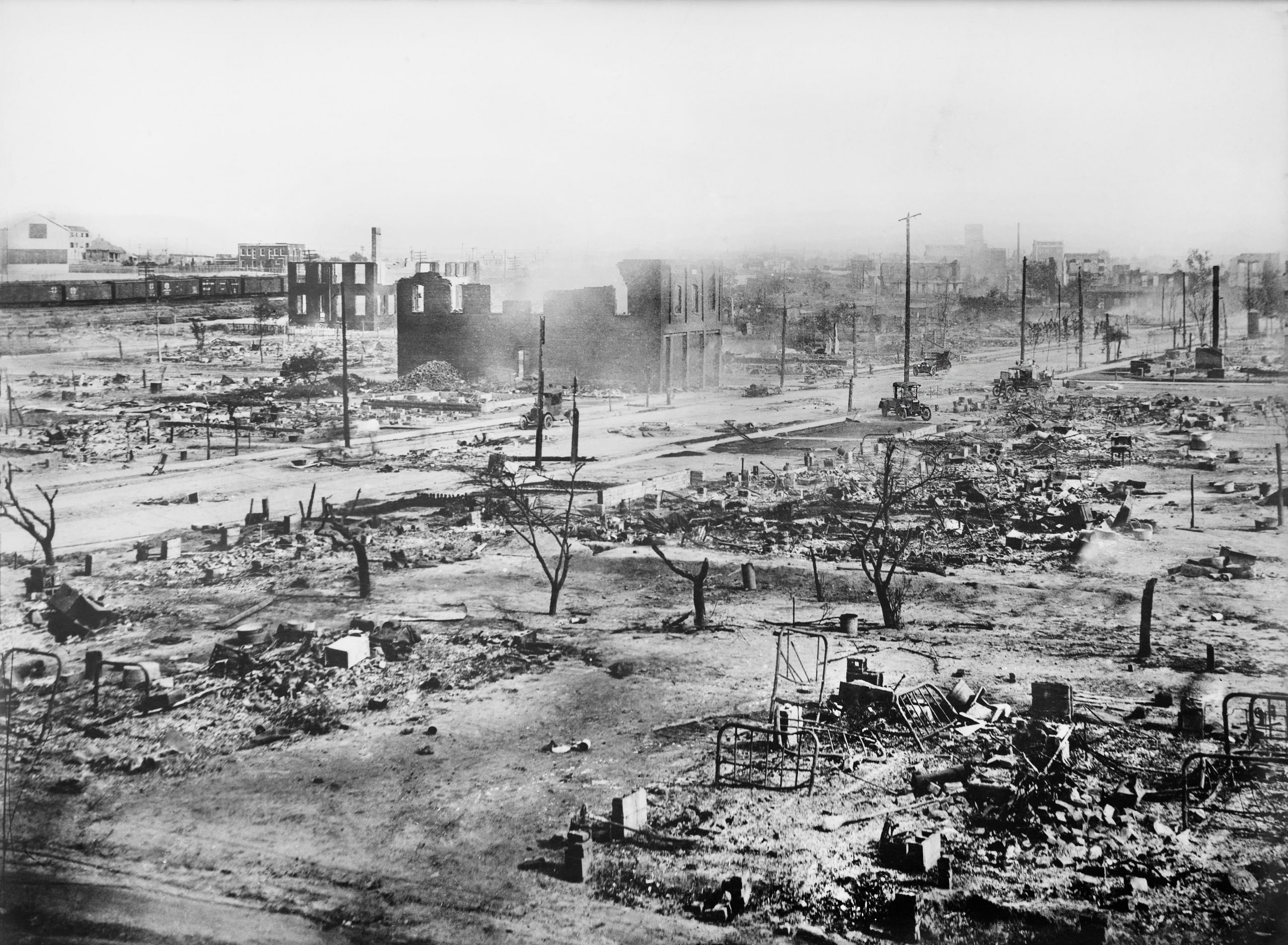
Ruins of the Greenwood District after the massacre of African Americans in Tulsa, Oklahoma, in June 1921. American National Red Cross photograph collection.
GHI | Universal Images Group | Getty Images
A century ago this week, the wealthiest U.S. Black community was burned to the ground.
At the turn of the 20th century, the Greenwood District of Tulsa, Oklahoma, became one of the first communities in the country thriving with Black entrepreneurial businesses. The prosperous town, founded by many descendants of slaves, earned a reputation as the Black Wall Street of America and became a harbor for African Americans in a highly segregated city under Jim Crow laws.
On May 31, 1921, a white mob turned Greenwood upside down in one of the worst racial massacres in U.S. history. In the matter of hours, 35 square blocks of the vibrant Black community were turned into smoldering ashes. Countless Black people were killed — estimates ranged from 55 to more than 300 — and 1,000 homes and businesses were looted and set on fire.
A group of people looking at smoke in the distance coming from damaged properties following the Tulsa, Oklahoma, racial massacre, June 1921.
Oklahoma Historical Society | Archive Photos | Getty Images
Yet for the longest time, the massacre received scant mentions in newspapers, textbooks and civil and governmental conversations. It wasn’t until 2000 that the slaughter was included in the Oklahoma public schools’ curriculum, and it did not enter American history textbooks until recent years. The 1921 Tulsa Race Riot Commission was formed to investigate in 1997 and officially released a report in 2001.
“The massacre was actively covered up in the white community in Tulsa for nearly a half century,” said Scott Ellsworth, a professor of Afro American and African studies at the University of Michigan and author of “The Ground Breaking” about the Tulsa massacre.
“When I started my research in the 1970s, I discovered that official National Guard reports and other documents were all missing,” Ellsworth said. “Tulsa’s two daily white newspapers, they went out of their way for decades not to mention the massacre. Researchers who would try to do work on this as late as the early 1970s had their lives threatened and had their career threatened.”
The body of an unidentified Black victim of the Tulsa race massacre lies in the street as a white man stands over him, Tulsa, Oklahoma, June 1, 1921.
Greenwood Cultural Center | Archive Photos | Getty Images
In the week following the massacre, Tulsa’s chief of police ordered his officers to go to all the photography studios in Tulsa and confiscate all the pictures taken of the carnage, Ellsworth said.
These photos, which were later discovered and became the materials the Oklahoma Commission used to study the massacre, eventually landed in the lap of Michelle Place at Tulsa Historical Society & Museum in 2001.
“It took me about four days to get through the box because the photographs were so horrific. I had never seen those kinds of pictures before,” Place said. “I didn’t know anything about the riot before I came to work here. I never heard of it. Since I’ve been here, I’ve been at my desk to guard them to the very best of my ability.”
Patients recovering from injuries sustained in the Tulsa massacre. American National Red Cross Photograph Collection, November 1921.
Universal History Archive | Universal Images Group | Getty Images
The Tulsa museum was founded in the late 1990s, but visitors couldn’t find a trace of the race massacre until 2012 when Place became executive director, determined to tell all of Tulsa’s stories. A digital collection of the photographs was eventually made available for viewing online.
“There’s still a significant number of people in our community who don’t want to look at it, who don’t want to talk about it,” Place said.
‘The silence is layered’
Not only did Tulsa city officials cover up the bloodbath, but they also deliberately shifted the narrative of the massacre by calling it a “riot” and blaming the Black community for what went down, according to Alicia Odewale, an archaeologist at University of Tulsa.
The massacre also wasn’t discussed publicly in the African American community either for a long time. First out of fear — if it happened once, it can happen again.
“You are seeing the perpetrators walking freely on the streets,” Odewale said. “You are in the Jim Crow South, and there are racial terrors happening across the country at this time. They are protecting themselves for a reason.”
Moreover, this became such a traumatic event for survivors, and much like Holocaust survivors and World War II veterans, many of them didn’t want to burden their children and grandchildren with these horrible memories.
Ellsworth said he knows of descendants of massacre survivors who didn’t find out about it until they were in their 40s and 50s.
“The silence is layered just as the trauma is layered,” Odewale said. “The historical trauma is real and that trauma lingers especially because there’s no justice, no accountability and no reparation or monetary compensation.”
A truck carries African Americans during race massacre in Tulsa, Oklahoma, U.S. in 1921.
Alvin C. Krupnick Co. | National Association for the Advancement of Colored People (NAACP) Records | Library of Congress | via Reuters
What triggered the massacre?
On May 31, 1921, Dick Rowland, a 19-year old Black shoeshiner, tripped and fell in an elevator and his hand accidentally caught the shoulder of Sarah Page, a white 17-year-old operator. Page screamed and Rowland was seen running away.
Police were summoned but Page refused to press charges. However, by that afternoon, there was already talks of lynching Rowland on the streets of white Tulsa. The tension then escalated after the white newspaper Tulsa Tribune ran a front-page story entitled “Nab Negro for Attacking Girl In Elevator,” which accused Rowland of stalking, assault and rape.
In the Tribune, there was also a now-lost editorial entitled “To Lynch Tonight,” according to Ellsworth. When the Works Progress Administration went to microfilm the old issues of the Tribune in the 1930s, the op-ed had already been torn out of the newspaper, Ellsworth said.
Many believe the newspaper coverage undoubtedly played a part in sparking the massacre.
The aftermath
People stand outside the Black Wall Street T-Shirts and Souvenirs store at North Greenwood Avenue in the Greenwood District of Tulsa Oklahoma, U.S., on Thursday, June 18, 2020.
Christopher Creese | Bloomberg | Getty Images
For Black Tulsans, the massacre resulted in a decline in home ownership, occupational status and educational attainment, according to a recent study through the 1940s led by Harvard University’s Alex Albright.
Today, there are only a few Black businesses on the single remaining block in the Greenwood district once hailed as the Black Wall Street.
This month, three survivors of the 1921 massacre — ages 100, 106 and 107 — appeared before a congressional committee, and a Georgia congressman introduced a bill that would make it easier for them to seek reparations.
Rev. Dr. Robert Turner of the Historic Vernon Chapel A.M.E. Church holds his weekly Reparations March ahead of the 100 year anniversary of the 1921 Tulsa Massacre in Tulsa, Oklahoma, U.S., May 26, 2021.
Polly Irungu | Reuters
Meanwhile, historians and archaeologists continued to unearth what was lost for decades. In October, a mass grave in an Oklahoma cemetery was discovered that could be the remains of at least a dozen identified and unidentified African American massacre victims.
“We are able to look for signs of survival and signs of lives. And really look for those remnants of built Greenwood and not just about how they died,” Odewale said. “Greenwood never left.”
— CNBC’s Yun Li is also co-author of “Eunice Hunton Carter: A Lifelong Fight for Social Justice.”


 Signal2forex.com - Best Forex robots and signals
Signal2forex.com - Best Forex robots and signals




